Have you recently stumbled upon a video clip randomly and want to find its full version to watch? Or perhaps you've heard about a specific incident in a video and want to verify its authenticity? Regardless of your reason for searching for the source of a video, there are many ways you can do it.
How to Find the Original Source of Any Online Video
There are many videos internet and on social media with unclear sources. These videos may contain important information that could lead to significant decisions. While some of these methods may require manual intervention, there are also technological tools that can simplify the process. Here is an overview of the best methods you can use to trace the source of an online video.
How to Search for the Source of Any Video Online and social networking sites
We present you with 5 methods you can use to investigate the source of the videos you watch on social media or the internet.
Search for the Video Source Manually
Manually searching on search engines like Google, Bing, Yandex, or their alternatives is a simple way to discover the source of a video.
Despite its simplicity, this method isn't always the most reliable option and may require significant time to sift through numerous results. There's no guarantee that you'll always find the video you're looking for.
To find the source of a video using this approach, you should first search for clues within the video itself, such as its content, the names of people appearing in it, or even some phrases from the dialogue.
For example, if you watched a video showcasing meat production in a factory and it mentioned the name of one of the factory managers, you can utilize this information and other clues, like the factory's name, to initiate your search.
After collecting these hints, you can consolidate them and use your preferred search engine. Then, review the results displayed by the search engine to determine if there's a suitable video you can find.
Use Google's advanced video search tool
To find the source of the video using the advanced video search tool provided by Google, you are required to do the following steps:
2. Fill in the fields based on the information collected previously.
3. Filter video clips by language, duration, time, and more to narrow down your search results.
4. Click on the "Advanced Search" button.
Afterward, Google will provide you with results related to your search. It's recommended to review and go through them to verify if you've found the video you're looking for.
Reverse video search using screenshots
Reverse video search using screen captures is considered one of the easiest and most effective methods to identify the source of a video. This approach involves capturing screen grabs from the desired video clip and then uploading them to a reverse image search engine. Here, the algorithm meticulously analyzes colors, pixels, and other components to assist you in identifying the potential source of the video.
Reverse Image Search Engine Sites
After taking pictures, you can perform reverse image searches. All you need to do is upload the snapshots to any of these tools and see if they can lead you to the desired source of the video. By using services like:
Find the source of the video with the Fake News Debunker extension
This extension is primarily used by journalists to identify news sources. Additionally, you can creatively use the Fake News Debunker extension to identify video sources. Here's how to make the most of this extension in more detail:
2. Once added, click on the extension and select "Open Toolbox."
3. Go to the "Video" tab and go to the "Keyframes" section, here you can split the video.
4. Paste or upload the video link in the "Video Source" section, then click "Submit". The tool will pull frames from the video timeline and present them as screenshots.
5. Right-click on any of these frames and expand the "Fact Check" menu from the context menu. Then, select the search engine you want to use.
6. Go to the search results and check if the search engine can identify the video's source. If reverse search fails in one search engine, try another.
7. Keep in mind that images with more visual elements and clearer content help search engines find related videos faster. So, choose the image carefully for your reverse search.
Use on-screen elements to identify the video's source
The elements within the video can also help you pinpoint the source more accurately. Web pages and online accounts often repost videos from other sources without any modifications. If the original publisher's logo or brand name is present and clear in the video, you can use this information to determine the original source. Therefore, when watching the video, be cautious and pay close attention to the elements on the screen.
If the brand name or logo is in the video, you can search for the brand and visit its social media accounts. You might find the video there. Additionally, you can use any other visual elements to trace the source of the clip.
Remember that some publishers may use their logos in others' content in a way that is not always fair. So, always ensure the credibility of the sources before relying on them completely.
We hope you find these tips useful on your journey to find the source of video content. You may find yourself with multiple options to achieve this goal. You may need to refine your search to increase your chances of success, especially if you don't know the source from the beginning. If Google or any other search engine fails to identify the video's source, don't hesitate to explore less popular specialized search engines. These engines may provide better performance in some cases and can be a good alternative to comprehensive searching.







